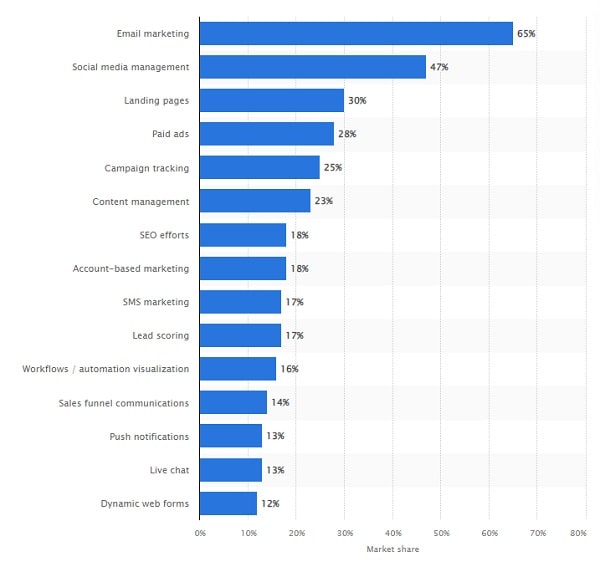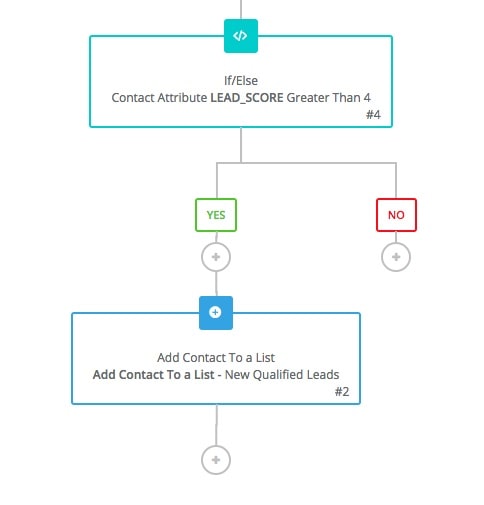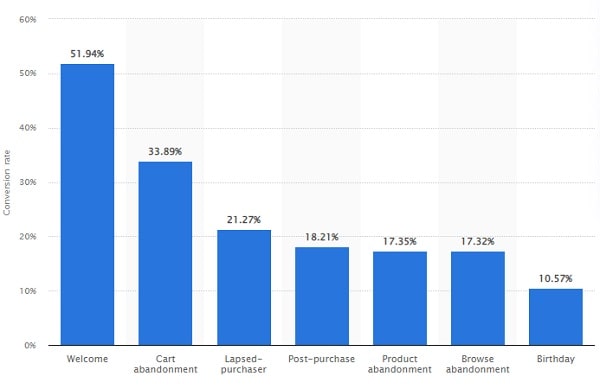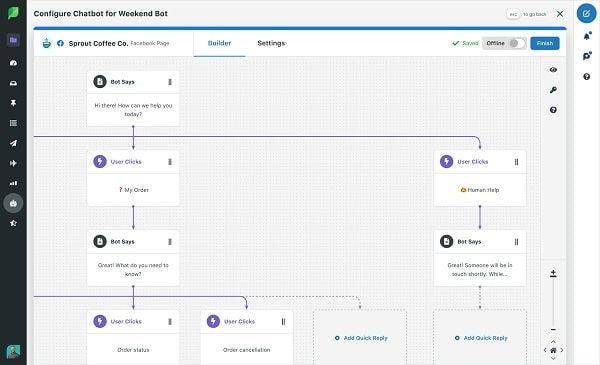The height of the coronavirus pandemic observed 10 years of eCommerce growth happening in just 90 days. Naturally, online shops are facing tremendous competition, and the scenario is not expected to change in the upcoming year. Your business has to evolve constantly with strategies that can overpower the competitors and accelerate the growth in the proper direction.
Automation seems to be the best way to streamline your eCommerce workflows to achieve an upper hand here. Marketing automation has resulted in a 34% increase in sales revenue. This is because automation recognizes the manual, repetitive and monotonous processes that can be performed just as well or, in most cases, even better.
Employing automation software help avoid valuable staff hours, and you get the same job done just as efficiently. It frees up your and your employees’ time to engage better in customer interactions, creative thinking, and plan out other long-term strategies for your online business.

Marketing processes that use automation
Let’s explore some eCommerce business processes that can be automated to improve your bottom line.
1. Inventory Management
Inventory management is crucial for every eCommerce business owner. Research has shown that running out of stocks, overstocking, or return of products leads to retailers losing approximately $1.75 trillion.

Investing in the proper inventory management saves time spent manually updating the inventory through Excel sheets. A few other notable advantages include real-time visibility, eliminating stock miscalculations, and greater scalability for your business.
But how does Enterprise Resource Planning (ERP) automation software help with all that you ask?
Here’s how:
Sends Real-time Reports
Your automation software can help you keep track of the product supply chain process with detailed reports. It provides real-time data with comprehensive notifications in case of low inventory, overstocks, and supplier or shipping delays. These analytics lead to making better business decisions that enable quicker delivery, enhanced customer satisfaction, and higher sales.
Manages the Stock
An automated inventory management software will tackle crucial backend operations like reordering, stock transfer, and order segmentation. This will ensure that your inventory has the right volume of popular products on your shelves. Automated stock transfer to the micro-fulfillment centers enables the distributors to find the stock at the right location and meet the demands promptly. This decreases the churn rate, thereby maximizing your sales.
Automates Order Dispatch Process
Integration of automation software with your eCommerce CRM can lead to streamlining the dispatch possess as well. The software can sort packages where they are to be delivered through label printing, barcode scanning, and delivery channel optimization. You can segregate and ship the priority orders through an air freight service and never miss another delivery date because of delayed dispatch.
2. Lead Scoring
Identifying the best leads once required extensive human attention and several resources. Automation through lead scoring has resulted in eliminating a lot of fluff out of the operation and turning it into a repeatable, data-driven procedure.
The automation software is pre-conditioned by you to assign a numerical or alphabetical score to your leads. It then adds the individual score based on who the lead is, where they work, how they have interacted with your website, and a plethora of other actionable data points. If the resultant score reaches a tipping point, the software automatically takes the determined action. This turns into an if-this-then-that process and tracks the potential customer on their behavior and identity attributes.

If-This-Then-That automation model for lead scoring
Automated lead scoring systems can massively impact your sales number. You find out the exact amount of effort needed according to the score and can dedicate specific efforts that lead to conversions. The top-scoring leads absolutely need the product or service you are offering and are aware of your eCommerce business. In contrast, cold leads can be further segregated and nurtured by automatically sending customized content based on the exact position in the sales funnel.
3. Email Marketing
There is no doubt that emails are still the leading channel for delivering personalized content, even decades after their inception. They are the quickest and all-encompassing method to reach your target audience on their personal devices. This is backed by the fact every $1 spent on email marketing campaigns produces a substantial return on investment of $36. Automating this process can only further increase its potency.
Automation of email marketing enables the execution of some well-thought sales campaigns. The automation software can maximize personalization and improve engagement by crafting unique messages for the right audience and sending them at the appropriate time.
The software is triggered by Tags, i.e., keywords that help identify the lead score. You can predetermine the tags. For example, tag a potential client when they sign up for a newsletter, buy a product or just click a link in a message.
A few examples of email marketing automation campaigns that drive sales are:
- Welcome emails for onboarding a new subscriber
- Targeted content for a lead magnet
- Re-engage sleepy subscribers with discount coupons
- Collect feedback through surveys
- Cart abandonment reminders
- Reaching out on special occasions like birthdays

Automated email marketing conversion rates by type of content
4. Social Media Marketing
You can improve your online store’s social media presence through automated content curation and posting schedules. The software can also be used to generate content ideas for various platforms. This way, you are equipped with regular posts that encourage engagement and have enough time on your hands to create fresh pieces. A few useful applications of social media automation tools include:
Social Listening
Keeping a tab on what the audience is saying about your eCommerce store across social media is called social listening. Manually, the process can become quite tedious. However, using the automation tools can help monitor the brand mentions on such platforms by bringing them together in one place.
Apart from checking your popularity, you can also follow keywords, hashtags, or topics specific to your niche. This will help you remain updated about the current trends, come up with content ideas for your social media posts, and tweak your social media strategy accordingly.
Consistency Through Scheduling
Employing automation techniques can let you schedule a steady queue of content ahead of time. Such consistency establishes a pattern and helps cement the follower’s trust in your brand. When you have the posts planned in advance, the members of the team can invest their time in actually engaging and interacting with the audience creatively.

A content calendar for better planning
In-depth Analytics
Acing the social media game can be tricky. You have to be wary about posting at the most appropriate time, know what kind of posts the audience interacts with the most, and maintain a substantial engagement rate.
Incorporating an automated tool is the easiest way to chart these metrics. You can get quantifiable results of your unique impressions, engagement and reach from all social media platforms. The tool will help optimize the marketing campaign and make gauging success a little simpler.
5. Customer Support
Every store, brick, and mortar or eCommerce, has to prioritize streamlining its customer support processes. Approximately 90% of online shoppers consider an immediate response when they have a customer service question an essential factor while interacting with any brand.
Automation combined with AI can come to the rescue in such cases. They can ease the support staff’s job by reducing the Average Handle Time of every query simultaneously increasing First Call resolutions. This is done by using a process automation system that is able to access your CRM and gather data about the customer, their orders, registered complaints, as well as any other related information.

Automated responses from a chatbot
Call centers can address many more problems during the first call, effectively increasing customer experience, thanks to quick, automatic access to all essential information, including data about previous client purchases and behavior patterns.
Another way to use Automation for the customer support process is to design and omcor[prate chatbots for your website and social media platforms. These can be wired to interact with customers, identify their intent and solve the necessary issues.
Chatbots can handle data collection and can also be used for the conversation itself. Natural Language Processing (NLP) is used to better understand the requirements of clients. Incorporating this connection through multiple channels like websites, enterprise apps, plus FB Messenger, Whatsapp, WeChat, Slack, Mail, and Skype can make it easy for customers to reach out and seek the necessary help.
Related Content
- The 5-Minute Guide to Optimizing for Email Automation Success
- What is Email Automation & How Can Your Business Use it?
- 4 Ways Automation has Revolutionized E-commerce
- Modern Real Estate Marketing: Marketing Automation Examples
- 15 Email Automation Stats that Might Surprise You
Wrapping up
You have a lot of competition as an eCommerce firm. Customers have never had it easier to shop online, and they have never had such a wide range of options. To ensure that you outperform your competitors, you must perfect all of your company processes. Here’s how the workflow automation concepts listed above might maximize your company’s potential:
- You can automate the inventory management process to replenish the depleting shelves in real-time to reduce the bounce rates.
- Next, setting a lead scoring algorithm improves conversions for your eCommerce as you do not have to invest your resources in chasing inappropriate leads.
- Incorporating automation techniques into your email marketing strategies only makes them stronger by engaging the buyer at the appropriate time.
- Automation techniques elevate your social media marketing game with top-notch social listening that helps gauge the audience’s sentiments and needs about your brand.
- Customer support automation via chatbots ensures that you can address shoppers’ queries and requests in the most efficient manner.
Streamlining and automating operations improves productivity and efficiency. Therefore workflow automation is an integral necessity for your eCommerce business and something that you simply cannot overlook.

Written by our guest writer Tim Robinson, Digital Marketing Manager at PACK & SEND
PACK & SEND is a 25+ years old and respected brand in eCommerce, logistics, and freight delivery solutions. Tim has 20 years of combined experience in sales and marketing. Logistics, D2C, franchising, business planning, and operations management are his core expertise. Connect with Tim on LinkedIn.



